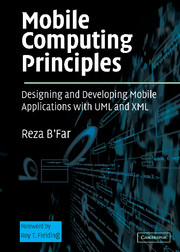Book contents
- Frontmatter
- Contents
- Foreword by Roy T. Fielding
- Acknowledgments
- SECTION 1 INTRODUCTIONS TO THE MAIN TOPICS
- SECTION 2 DEVICE-INDEPENDENT AND MULTICHANNEL USER INTERFACE DEVELOPMENT USING UML
- SECTION 3 ADDITIONAL DIMENSIONS OF MOBILE APPLICATION DEVELOPMENT
- SECTION 4 PUTTING THE PROJECT TOGETHER
- References
- Index
Foreword by Roy T. Fielding
Published online by Cambridge University Press: 03 September 2009
- Frontmatter
- Contents
- Foreword by Roy T. Fielding
- Acknowledgments
- SECTION 1 INTRODUCTIONS TO THE MAIN TOPICS
- SECTION 2 DEVICE-INDEPENDENT AND MULTICHANNEL USER INTERFACE DEVELOPMENT USING UML
- SECTION 3 ADDITIONAL DIMENSIONS OF MOBILE APPLICATION DEVELOPMENT
- SECTION 4 PUTTING THE PROJECT TOGETHER
- References
- Index
Summary
Back and forth, back and forth …
Four years ago, Reza and I were working together at eBuilt when he first stopped by my office to talk about frameworks for wireless application development. We were in the final months of the so-called “dot-com era,” when dreams of a new economy allowed just about anyone to get funding for a network-based application, particularly when it also involved some form of mobile computing device. Those people with ideas (and sometimes funding) would come to our company and ask us to implement their vision. Of course, they would also ask for a few miracles, such as a working prototype within a month and deployment across all devices in six months. Oddly enough, we could actually accomplish implementations like that, if it were not for one problem out of our control: mobile devices had a market lifetime of only about four months.
It was the year 2000, just a couple months after Y2K became a non-issue, and there was so much variance in the types of mobile devices, both in terms of their feature sets and in their application development environments, that an application developed for one device environment would be obsolete by the time it was ready to market. Reza had a solution in mind and was determined to get, which is why he was busy pacing in my office.
- Type
- Chapter
- Information
- Mobile Computing PrinciplesDesigning and Developing Mobile Applications with UML and XML, pp. xi - xivPublisher: Cambridge University PressPrint publication year: 2004



